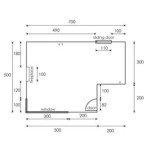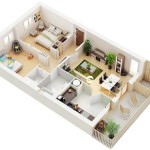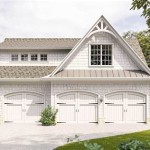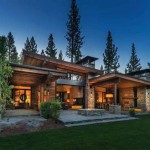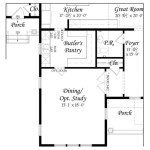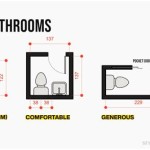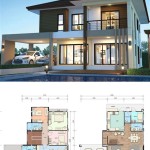Simple 1 Bedroom Apartment Floor Plans With Dimensions In Meters
Space optimization is a primary concern when designing a one-bedroom apartment. Efficient floor plans maximize usable area while maintaining a comfortable living environment. Understanding the dimensions and layout options is crucial for renters and owners alike seeking to personalize and furnish their space effectively. This article will explore various simple one-bedroom apartment floor plans, providing dimensions in meters and highlighting key considerations for each.
When analyzing a one-bedroom apartment floor plan, several factors influence the perception of space. Ceiling height, natural light availability, and the flow between rooms all contribute to the overall feel. A well-designed plan considers these elements and incorporates them to create an environment that feels larger and more inviting than its measured square meterage might suggest.
The specific layout will dictate how effectively furniture can be arranged and how comfortably occupants can move throughout the apartment. The dimensions provided are crucial for determining whether desired furniture pieces will fit and allow for adequate circulation. Furthermore, understanding the location of windows and doors is essential for optimizing natural light usage and minimizing obstructions to the flow of movement.
Understanding Standard Dimensions and Layout Components
A typical one-bedroom apartment floor plan consists of several essential components: a living area, a kitchen, a bedroom, a bathroom, and potentially a small entrance hallway or storage area. Each of these areas requires careful consideration in terms of size and arrangement. The overall dimensions of the apartment will dictate the relative size of each zone.
Living areas in smaller apartments typically range from 12 to 20 square meters. This space needs to accommodate seating, a television or entertainment center, and potentially a dining area, depending on the overall layout. The dimensions should allow for comfortable seating arrangements and sufficient circulation space.
Kitchens in one-bedroom apartments are often combined with the living area in an open-plan design. These kitchens are generally compact, ranging from 4 to 8 square meters. Efficient storage solutions, such as vertical shelving and multi-functional appliances, are crucial in maximizing space within these smaller kitchens. The layout, whether linear, L-shaped, or U-shaped, will influence the workflow efficiency and the amount of countertop space available.
Bedrooms typically range from 10 to 15 square meters. This space needs to accommodate a bed, bedside tables, and a wardrobe or closet. The dimensions should allow for comfortable movement around the bed and sufficient space for dressing. The location of windows and doors is critical for ensuring adequate natural light and ventilation while maintaining privacy.
Bathrooms are typically the smallest rooms in an apartment, ranging from 3 to 6 square meters. They need to accommodate a toilet, a sink, and a shower or bathtub. Efficient use of space is vital, with wall-mounted fixtures and storage solutions helping to maximize the usable area. The layout should allow for comfortable movement and prevent overcrowding.
Entrance hallways, if present, are typically small, ranging from 1 to 3 square meters. They serve as a transition space between the entrance and the main living area. Storage solutions, such as coat racks and shoe storage, are often incorporated into the hallway to minimize clutter.
Storage areas, such as closets or cupboards, are essential for minimizing clutter and maximizing usable living space. The size and location of these storage areas will vary depending on the overall layout of the apartment. Built-in storage solutions can be particularly effective in optimizing space in smaller apartments.
Examples of Simple One-Bedroom Floor Plans with Dimensions
The following examples illustrate different layouts for a simple one-bedroom apartment, with dimensions provided in meters. These are general examples and can be adapted to different architectural styles and specific building codes.
Example 1: Linear Layout (Total Area: approximately 35 square meters)
* Living Area/Kitchen: 5m x 4m (20 square meters). The kitchen is along one wall, with appliances and storage integrated into a linear design. * Bedroom: 3m x 3.5m (10.5 square meters). A standard double bed and small bedside tables can comfortably fit in this space. * Bathroom: 1.5m x 2.5m (3.75 square meters). This allows for a shower, toilet, and small sink area. * Entrance Hallway: 1m x 0.75m (0.75 square meters).
This layout is simple and efficient, suitable for smaller spaces. The open-plan living area promotes a sense of spaciousness, while the separate bedroom provides privacy. The linear kitchen layout maximizes usable space along one wall.
Example 2: Rectangular Layout (Total Area: approximately 45 square meters)
* Living Area: 4m x 4.5m (18 square meters). This larger living area allows for more flexible furniture arrangements. * Kitchen: 2m x 2.5m (5 square meters). A compact, L-shaped kitchen can fit into this space. * Bedroom: 3.5m x 4m (14 square meters). This spacious bedroom allows for a larger bed and more storage. * Bathroom: 2m x 2m (4 square meters). A square bathroom layout allows for efficient use of space. * Entrance Hallway: 1m x 2m (2 square meters).
This layout offers more space in both the living area and the bedroom. The dedicated kitchen area allows for better organization and functionality. The rectangular layout allows for distinct zones within the apartment.
Example 3: Square Layout (Total Area: approximately 40 square meters)
* Living Area/Kitchen: 5m x 4m (20 square meters). The kitchen is integrated into one corner of the living area. * Bedroom: 3m x 3.3m (9.9 square meters). * Bathroom: 2m x 2m (4 square meters). * Hallway: 2m x 3.05m (6.1 square meters).
This layout emphasizes a more compact design while maintaining a functional separation between the living and sleeping areas. The square shape allows for a symmetrical arrangement of furniture and a relatively even distribution of space. Storage along the hallway is important.
Key Considerations for Maximizing Space and Functionality
Beyond the basic dimensions, several design choices can significantly impact the perceived space and functionality of a one-bedroom apartment. These considerations include furniture selection, color schemes, lighting, and storage solutions.
Furniture selection is crucial for maximizing space utilization. Multi-functional furniture, such as sofa beds, storage ottomans, and folding tables, can significantly reduce clutter and provide flexibility. Choosing furniture with a smaller footprint and a minimalist design can also help to create a more spacious feel. Consider wall-mounted options to save floor space.
Color schemes play a significant role in creating the illusion of space. Light colors, such as white, beige, and light gray, reflect more light and make spaces appear larger. Using a consistent color palette throughout the apartment can also create a sense of continuity and flow, further enhancing the perception of space. Accent colors can be used sparingly to add visual interest.
Lighting is essential for creating a bright and inviting atmosphere. Natural light should be maximized by keeping windows unobstructed and using sheer curtains. Artificial lighting should be layered, with a combination of ambient, task, and accent lighting to provide adequate illumination for various activities. Mirrors can be used to reflect light and create the illusion of more space.
Storage solutions are critical for minimizing clutter and maximizing usable living space. Built-in storage, such as shelving and cabinets, can be customized to fit specific needs and maximize vertical space. Using storage containers and organizers can also help to keep belongings neatly organized and out of sight. Consider vertical storage solutions to make the most of space.
The placement of appliances must also be carefully considered, especially in kitchen spaces. Integrated appliances create a seamless look and save space. Utilizing compact and energy-efficient appliances can also contribute to a more sustainable and functional living environment.
Ultimately, the ideal one-bedroom apartment floor plan depends on individual needs and preferences. By carefully considering the dimensions, layout options, and design considerations, renters and owners can create a space that is both functional and aesthetically pleasing.
Furthermore, when assessing floor plans, it's important to remember the impact of load-bearing walls. Altering these structural elements can be costly and may not be permitted in all buildings. Therefore, finding a floor plan that already suits the occupant's needs is generally preferable to undertaking significant renovations. Consulting with an architect or interior designer can provide valuable insights and help to optimize the layout of even the smallest one-bedroom apartment.

1 Bedroom Apartment Plan Examples

Log Plan 960 Square Feet 1 Bedroom Bathroom Floor 035 00244 America S Best House Plans

1 Bedroom Apartment Plan Examples

Top 7 One Bedroom House Plans To Help You Get Started

Studio Apartment Floor Plans Examples Design Steps Cedreo

Affordable One Bedroom Design For 7 X 6 Meters Lot Ulric Home

Top 7 One Bedroom House Plans To Help You Get Started

1 Bedroom Apartment House Plans

Simple One Bedroom House Plans Architectural Drawings Dream

1 Bedroom Apartment House Plans
Related Posts


